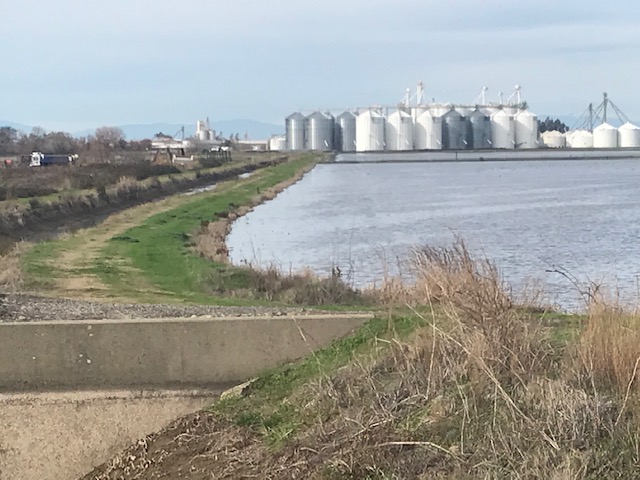 Publisher’s Note: These two pieces are reprints curtesy of the Northern California Water Association. Some folks are under the opinion that the Sacramento Valley always has enough water. The unintended (or maybe not) consequences of the state’s storage and policy/management issues impact all of California.
Publisher’s Note: These two pieces are reprints curtesy of the Northern California Water Association. Some folks are under the opinion that the Sacramento Valley always has enough water. The unintended (or maybe not) consequences of the state’s storage and policy/management issues impact all of California.
By Jim Mayer Chair, NCWA Groundwater Management Task Force; and Board Member, Yolo County Flood Control and Water Conservation District
With the Sacramento Valley facing an unprecedented dry year – particularly on the west side where little or no surface water is available – concerted efforts are being made to carefully manage groundwater resources for communities and farms this summer, while keeping an eye toward longer-term regional sustainability of water resources. This is not an accident.
Last fall, the Northern California Water Association convened three scenario planning sessions working with state and federal agencies and conservation partners to identify early actions, cooperative approaches, and creative partnerships that could help mitigate the economic, social and environmental impacts should 2022 turn out to be another dry year.
This process explored opportunities from ridgetop to river mouth to protect our communities, jobs and ecosystems from further harm in the short run while strategies are pursued to achieve long-term resilience in the face of a changing climate.
The third session focused specifically on groundwater and produced four immediate priorities for implementing the Groundwater Sustainability Plans (GSPs) approved by local agencies this winter and submitted to the State for review. Those priorities, detailed below in A Pathway for the Future:
Sustainable Groundwater Management in the Sacramento Valley, are:
- Ensure safe drinking water for communities
- Advance groundwater recharge opportunities
- Better understand and manage surface water and groundwater interaction.
- Align state and federal priorities with local and regional needs.
Now in real time, NCWA also is supporting efforts by counties and Groundwater Sustainability Agencies (GSAs) to coordinate well permitting consistent with the provisions in the Governor’s recent Executive Order. See Drought Well Permitting Requirements, Drought Executive Order N-7-22.
The leadership in the Sacramento Valley, in our pursuit of overall resource resiliency, realizes the imperative to prevent all of the undesirable results described in the Sustainable Groundwater Management Act (SGMA), such as subsidence.
Overall, the scenario sessions renewed NCWA’s focus on the natural infrastructure of the Sacramento Valley—including the vast aquifer systems— and our commitment to develop more nature-based solutions to ensure sustainability.
The Northern California Water Association (NCWA) is working to bring the region together to actively manage our water resources—both surface and groundwater—for multiple benefits that ensure sustainable water supplies for cities and rural communities, farms, fish, birds, recreation, and hydropower. In managing water from the ridgetop to the river mouth, we fully appreciate and embrace the Sacramento Valley’s natural infrastructure, including our groundwater aquifer systems and their relation to both our rivers and creeks and the landscape that supports these vital rivers and creeks.
An Unprecedented Year: Dry Year Impacts in the Sacramento River Watershed
California is experiencing one of the driest years on record. The Sacramento River watershed has been especially impacted with the current storage in Lake Shasta at 1.7 million-acre-feet (maf), compared with the average 3.5 maf for this time of year. With the water suppliers on the Sacramento River (Sacramento River Settlement Contractors, SRSC) receiving approximately 15-18 percent of their supplies when their contract provides for 75 percent of supplies in critically dry years, we will see unprecedented and dire conditions, with significant impacts to every use of water:
- Extremely low supplies for agriculture resulting in substantial fallowing of crop lands.
- Significant environmental impacts to native fish, birds and other wildlife.
The CalEPA Secretary, working with other agencies and the SRSC, convened a leadership group to evaluate 2022 operations on the Sacramento River and develop the best available approach for cities, farms and fish and wildlife. See the CalEPA Informational Statement.
group to evaluate 2022 operations on the Sacramento River and develop the best available approach for cities, farms and fish and wildlife. See the CalEPA Informational Statement.
The following is a general estimate and an early summary on what we anticipate to see this year along the Sacramento River. These numbers, some of which will likely increase as the year emerges, will be refined as we learn more from the region this spring and summer.
Cities and Rural Communities:
Will only receive “health and human safety” surface water.
Fallowed Farmland:
Estimated acreage of all crops fallowed on the west-side of the Sacramento Valley: 370,000 acres of 450,000 in SRSC service area, primarily in Colusa and Glenn Counties.
Economies:
$925,000,000 direct on-farm impact (plus multiplier).
For the rice industry, $251 million direct and induced impacts on rice mills, dryers and suppliers, with more than $76 million attributed to the loss of wages for 1500 jobs.
Fisheries:
Temperature Dependent Mortality for Winter Run Salmon.
Will operate Livingston-Stone Conservation Hatchery for salmon (with capacity to cool water by 10 degrees to assist salmon).
Birds and Wildlife:
National Wildlife Refuges will receive 15-18 percent of water supplies late in season.
Ricelands are likely to be less than half of average production (Sacramento Valley-wide), significantly affecting food energetics for migratory waterfowl. The concern for potential disease outbreaks is significant as waterfowl will be forced to concentrate on what limited water is available. Reduced water for refuges and extremely limited ability to winter flood ricelands can create the perfect breeding grounds for botulism and avian cholera outbreaks, which can have significant population impacts.
With this challenging year, the water resources managers are working hard to provide limited water for all these important purposes in the most effective way possible. The leaders in the region have also come together and are working with state and federal leaders to seek creative ways to address all of these impacts on our communities and the fish and wildlife that are challenged with a very limited water supply.
If you have additional insights into the Sacramento River watershed that will be helpful to address these issues this year, please share them with info@norcalwater.org
 DISCLAIMER OF RESPONSIBILITY; WaterWrights.net strives to provide its clients and readers with the most complete, up-to-date, and accurate information available. Nevertheless, WaterWrights.net does not serve as a guarantor of the accuracy or completeness of the information provided, and specifically disclaims any and all responsibility for information that is not accurate, up-to-date, or complete. WaterWrights.net’s clients therefore rely on the accuracy, completeness and timeliness of information from WaterWrights.net entirely at their own risk. The opinions expressed in this report are those of the author and do not necessarily represent any advertisers or third parties. But sometimes (as Rush Limbaugh used to say) they should.
DISCLAIMER OF RESPONSIBILITY; WaterWrights.net strives to provide its clients and readers with the most complete, up-to-date, and accurate information available. Nevertheless, WaterWrights.net does not serve as a guarantor of the accuracy or completeness of the information provided, and specifically disclaims any and all responsibility for information that is not accurate, up-to-date, or complete. WaterWrights.net’s clients therefore rely on the accuracy, completeness and timeliness of information from WaterWrights.net entirely at their own risk. The opinions expressed in this report are those of the author and do not necessarily represent any advertisers or third parties. But sometimes (as Rush Limbaugh used to say) they should.
ALL RIGHTS RESERVED. Copyright 2022 by www.WaterWrights.net/DAW































